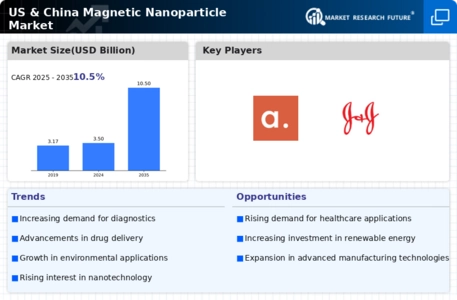Market Trends
Key Emerging Trends in the US China Magnetic Nanoparticle Market
The dynamic nature of trends in the U.S.A. and Chinese magnetic nanoparticle markets reflects continued advances in nanotechnology and growing use of magnetic nanoparticles across different industries. In America, this has been accompanied by considerable upward trajectory marked by substantial research activities mainly within medical applications and electronics sectors. Magnetic nanoparticles possess unique properties that make them useful for targeted drug delivery systems, imaging purposes or even contrast agents used during medical diagnostics. These factors have promoted collaborations between pharmaceutical firms together with research centers towards efficient medication thereby creating a demand for such solutions in US.
Across the globe from the U.S.A. to China, we have seen China emerge as a major player in the global magnetic nanoparticle market with rapid growth and innovation. The Chinese market has been boosted by various government initiatives, increased funds for research and development as well as a robust manufacturing sector. Consequently, it is currently one of the world’s biggest producers and exporters of magnetic nanoparticles which are not only supplied locally but also supporting global supply chains. This country is among the first that made discoveries in diverse applications of magnetic nanoparticles including environmental remediation or energy storage.
Meanwhile, both American and Chinese markets are marked by focus on green sustainability within magnetite particles. Researchers and industry players have invested into developing green synthesis methods and biodegradable magnetic nanoparticles because of growing concerns for the environment. This reflects a global shift towards sustainability with reducing nanoparticle environmental impact and responsible nanotechnology use being two related issues faced globally across numerous sectors.
Furthermore, the increasing number of collaborations between American and Chinese companies and research institutions has resulted in a dynamic exchange of ideas and information. This division has allowed resources to be pooled together while sharing technological expertise that led to the creation of novel magnetic nanoparticle products with better features. Thus, not only does this method speed up progress in the industry, but it also helps make the magnetic nanoparticle market global.
There is an increase in demand for magnetic nanoparticles in the electronic and IT sectors both in USA and China on market dynamics. This push for smaller components with greater efficiency has necessitated the adoption of magnetic nanoparticles into various electronic devices such as data storage systems or sensors due to the trend towards miniaturization of electronic gadgetry. In this race towards new technological horizons, both countries have made magnetic nanoparticles central towards progress within the field of electronics.





Leave a Comment